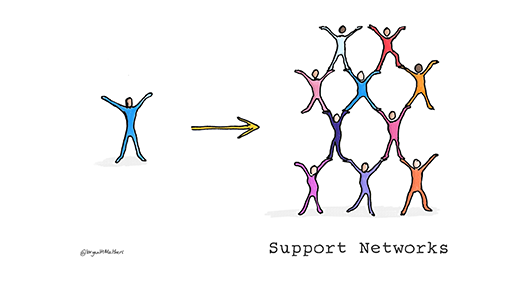Week 5 Communities and networks
Introduction
One of the most effective ways to build confidence and ability in teaching and supporting learners online is to connect and talk with others. This may involve forming a network of peers who are at a similar stage and can share experiences, test ideas and offer moral support. It may involve connecting to people who have already achieved the same objective and can provide useful advice.
A great advantage of using online tools, particularly social networking tools such as Telegram, WhatsApp or Facebook, is that individuals are not limited to one physical or online place. They can decide what to discuss, how, when and with whom. Participation in these networks is sometimes described as either active or passive.
Passive participation does not involve any online engagement that is visible to others. Simply reading the comments of others without initiating or responding to a post is a form of passive engagement (sometimes referred to as ‘lurking’). ‘Active’ online learners make contributions that are obvious to others, for example, sharing resources or discussing ideas.
However, these labels may be misleading because they are based on what can be seen of a learner’s activity online. From the perspective of those online, ‘passive’ learners appear not to be engaging because they make no obvious contribution. However, they may actually be very active – reading everything, making notes, bookmarking sites, and discussing ideas with friends and colleagues. On the other hand, ‘active’ learners may appear to be working hard because their activity is visible online, but – on closer inspection – their contributions may be low quality or off topic.
Understanding concepts such as synchronous and asynchronous communication will help with online teaching. These concepts apply to a variety of platforms and tools: for example, social networking tools include discussion or message boards. They also provide ways of sharing and curating information, for example through social bookmarking and micro-blogging. Individuals can share resources and findings of their work online and can also find information and resources shared by others with similar interests.
This week, you will cover the advantages that can be gained by expanding online networks, as well as guidelines and tips for developing professional networks.
Practitioner reflections
The week starts with another video from educator Sarah. Here she reflects on her experiences with online networks. As you watch the video or read the transcript, make a note of the different ways in which Sarah uses Facebook and Twitter to support her teaching.
Transcript
How have you developed your networks?
Learning outcomes
By the end of this week, you should be able to:
- stay up to date with how digital tools are changing learning and teaching practices;
- participate in and facilitate digital teams, working groups and networks;
- collaborate effectively in digital spaces;
- participate actively in social media relevant to your professional role and interests;
- share learning and teaching materials, presentations, resources etc. on appropriate digital sites and networks;
- develop and project a positive digital identity (or identities) in your professional role and manage your digital reputation across a range of platforms.

